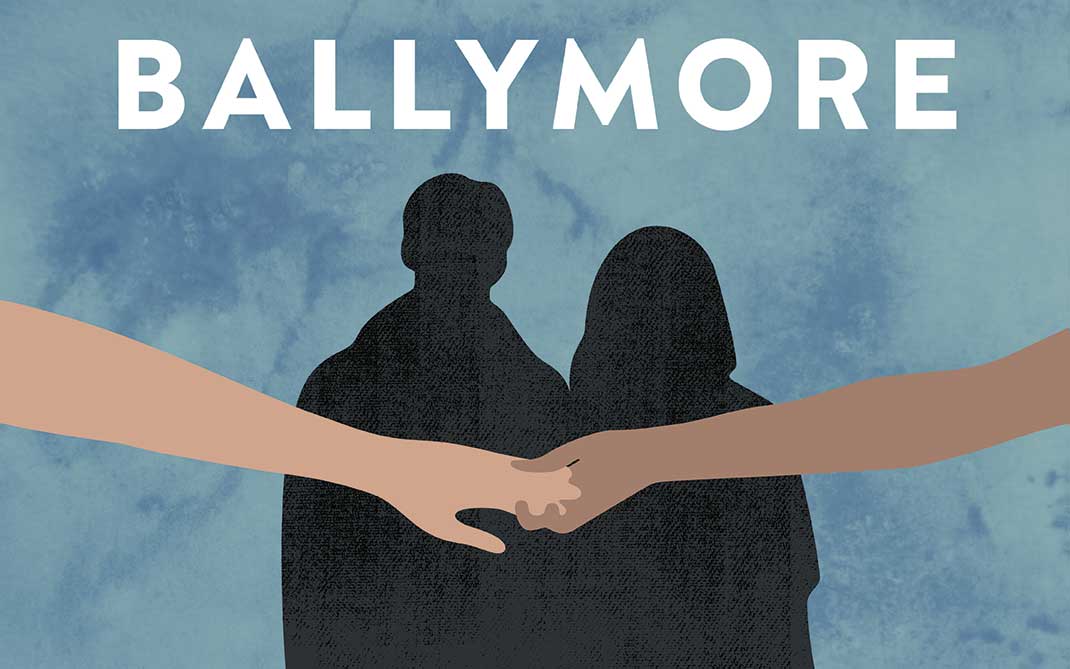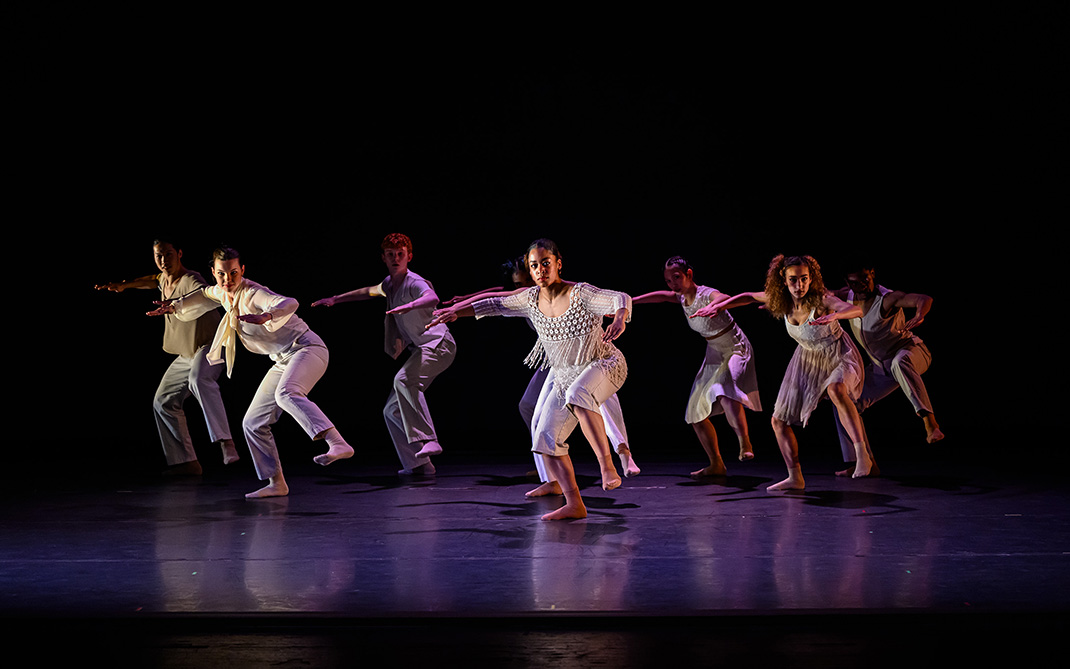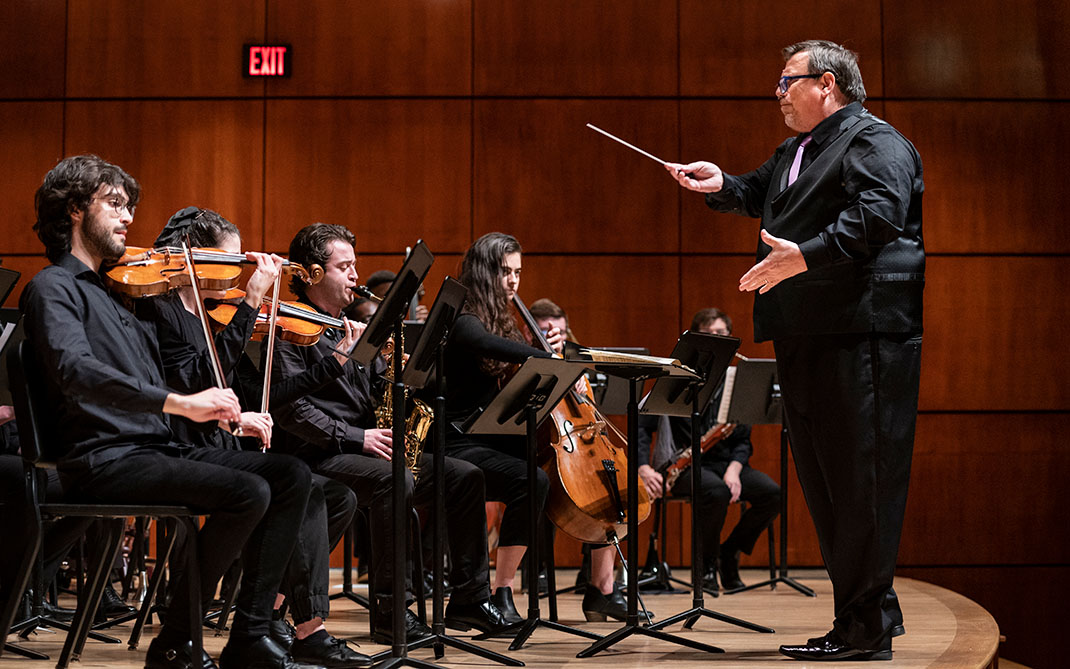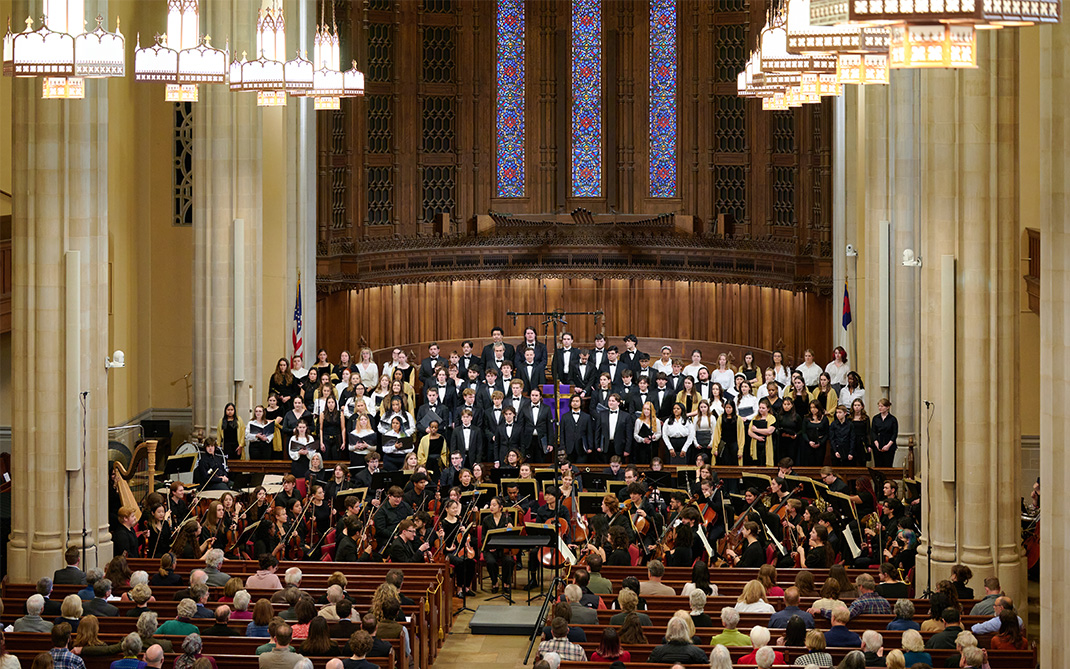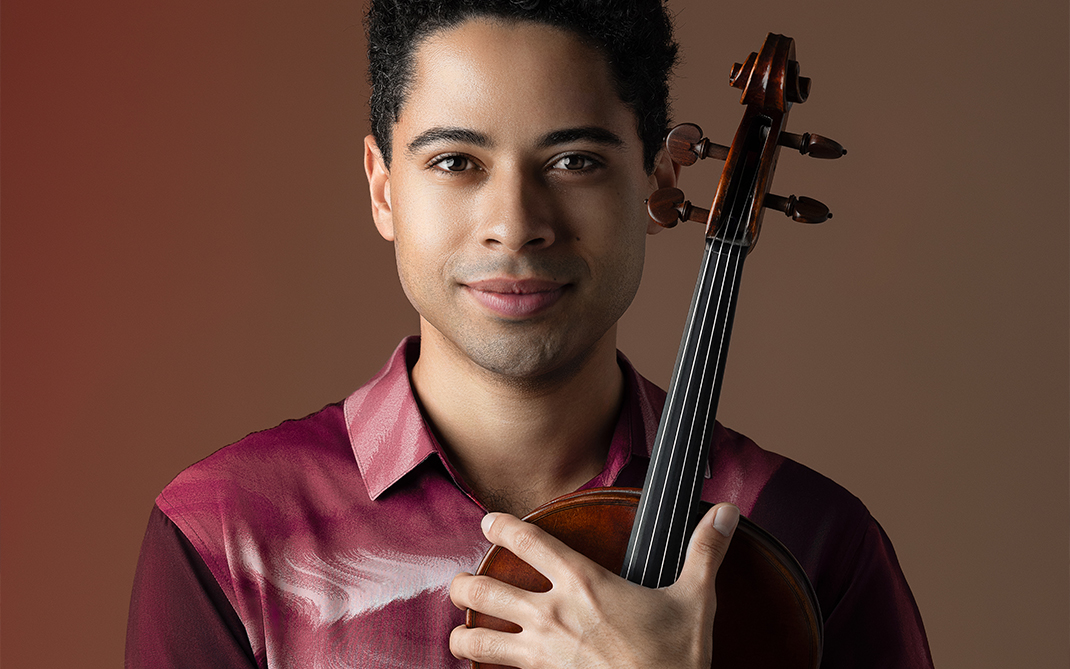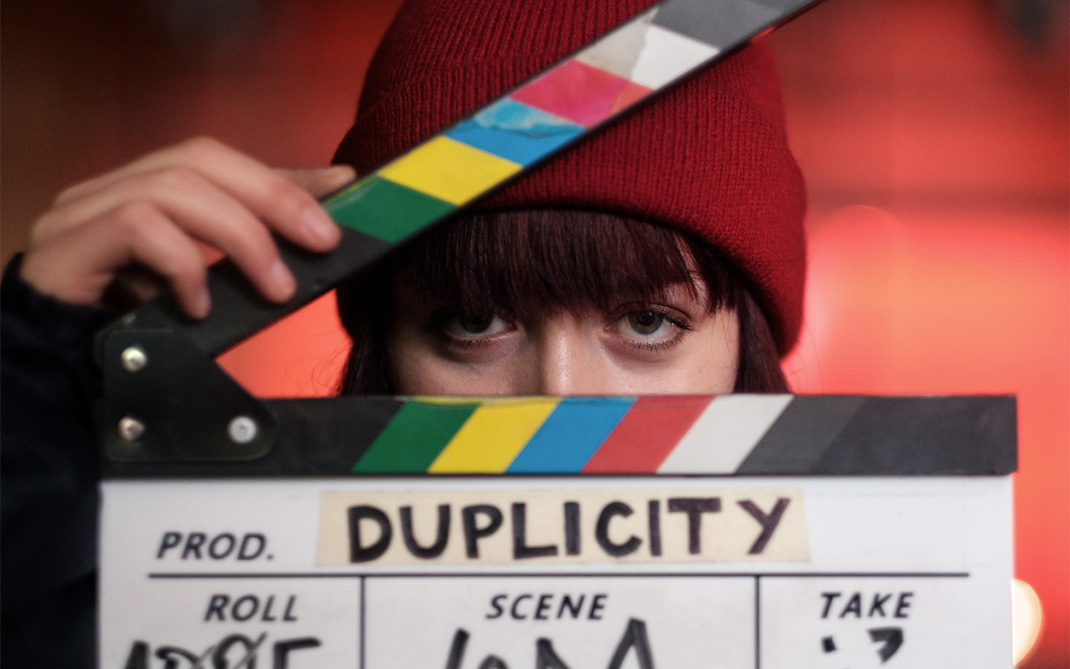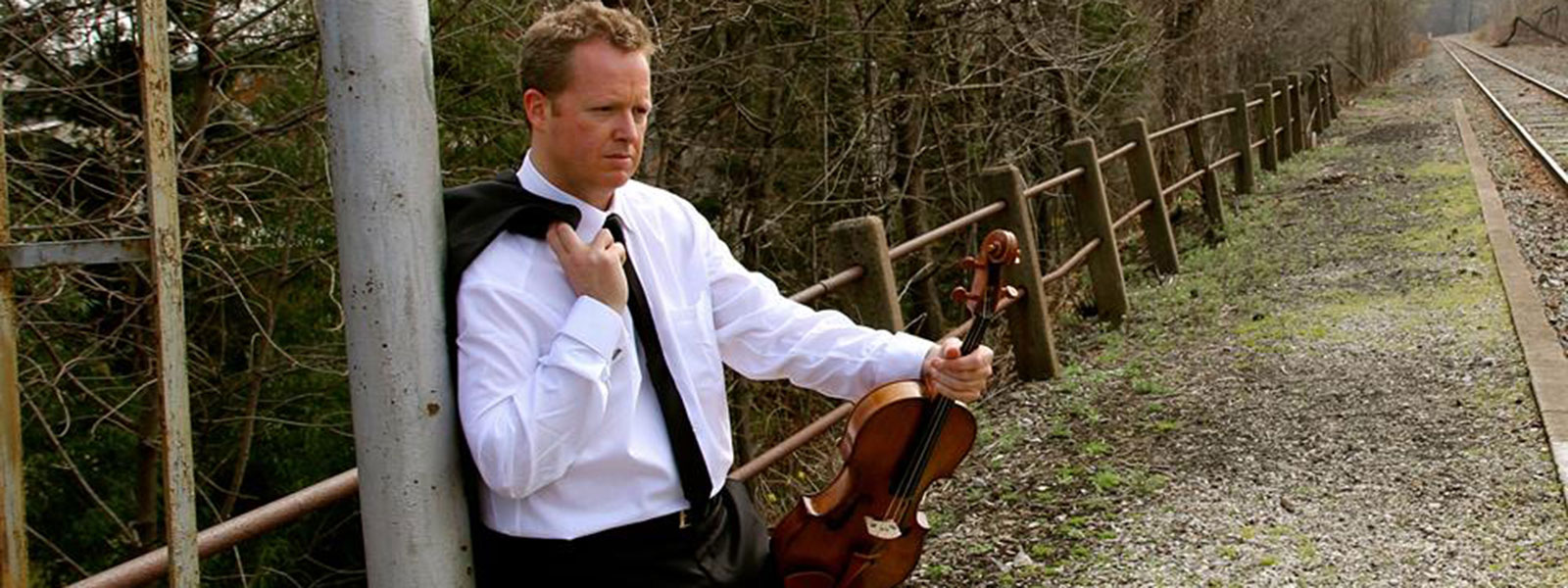The Artist as Leader: Brett Deubner
To say that violist Brett Deubner — who performed with the UNCSA Symphony Orchestra in Winston-Salem this spring for the world premiere of Bruno Louchouarn’s Sol Path — is an accomplished musician is an understatement, both of his talent and his impact on the future of classical music.
He shares many characteristics with others featured in The Artist as Leader series: He is willing to take risks, he embraces change and he seeks to inspire the young musicians that he teaches at the Aaron Copland School of Music.
His success as an artist, entrepreneur and educator is a reflection of his skill, passion and resilience, and we are pleased to include our conversation with him here.
Choose a question below to begin exploring the interview:
- How did your background inform your roles as an artist leader, teacher and entrepreneur?
- Do you consider yourself still a learner as an adult?
- How does your arts background influence how you work as a leader?
- How do you see the creative process translating to leadership?
- What do you mean when you say that artists are “desperately creative”?
- How can classical musicians find a balance between following tradition and breaking form?
- How are you helping younger artists understand their role in creating their own brand?
- Can you speak to the importance of an artist’s ability to be resilient?
- In terms of leadership, where in your career are you striking out the most?
- What is your greatest challenge as an artist leader?
- How do you defy some of the mythology surrounding classical musicians?
- What attributes do artist leaders need to be successful?
- How can we encourage more artists to lead?
- What advice would you have liked to receive when you were starting out as an artist leader?
- Do you have anything else you want to share about this question of artist leadership?
- Epilogue
CM: Brett, would you start by sharing about your background and how that might have informed the kind of artist leader you have become as a teacher and performer and entrepreneur?
BD: I was born in California and was adopted, and my parents are not musicians in any way, although we did have a turntable with a Harry Belafonte album that was worn to nothing. I think it was really because of the public schools in West Virginia. In fourth grade I took one of those music aptitude tests that everyone had to take way back in the early 1980s, and started on the violin and never looked back. I was lucky because my parents were very supportive, and I think that is probably one of the main reasons that I’m doing what I’m doing, because it’s a crazy field, going into music or going into the arts. My mom, being a trained actress, she saw that eccentricity and supported it and drove me everywhere to youth orchestra practices, private lessons and all that.
CM: Was that all in West Virginia?
BD: No, by then it was in St. Louis, junior high and high school, and in Houston, where I finished high school. Then I went to Eastman for both degrees, discovered the viola my freshman year, but stuck with violin and started studying viola at the same time. I found my niche early on as a new music person I think because I had the technique of a violinist playing the viola. Back then, that was a really good thing to have. If they wanted someone to do Pierrot Lunaire, I was the only one who could play both parts in the program, even though it’s often done with two different people. And a university is a great place to try and experiment with things. One of the things I love about traveling is going to universities and talking to the students about how now is the time to try things!
CM: Do you have a particular memory of why music attracted you when you were a kid?
BD: I had one of those tape cassette players with a microphone and really enjoyed playing violin duets. I’d play one part into the microphone and play it back, and then play other parts. So, at a very early age, I really enjoyed that kinetic feeling of having two things rub against each other. In some ways, different aspects of what I do started to percolate before I really knew what I was going to be, which wasn’t until I was like 38 anyway! But I think it was something that was just very natural for me to do. I never really remember at what point I decided I was going to do this — I just never stopped doing it.
RK: Did moving have an impact on your interests or your “cloistering” as a musician?
BD: No, partly because my parents were so supportive. Wherever we would move, it was a priority to make sure that I had a youth orchestra and a teacher. And it was serendipitous that my very first serious violin teacher in St. Louis, one of his closest friends was in Houston, where I next moved. And then I went to college and studied with another person who was practically her sister. So all three of my teachers over those 15 years studied with Ivan Galamian at the exact same time. It was kind of like having a family in a way. I liked going different places for three years and then going somewhere else, I was comfortable being by myself, but I also really liked seeing different places. I was one of those kids that didn’t have a thousand friends, I had two really good friends everywhere I went.
Another thing is I never thought, ‘Wow I’m really good.’ I still don’t think that, but I never did competitions, at least serious ones. I was always thought of as just a quick study and someone who had a lot of energy and a lot of talent. But because I didn’t come from a musical family, those were circles that I circumvented for better or for worse.
RK: Do you still consider yourself a learner? Still growing?
BD: Oh, yeah. Now, in my old age of 48, I love teaching more and more because the older I get, the more I’m helping others to figure it out. That kind of informs me, too.
CM: Do you find that articulating how you play, helps you play?
BD: Yes, to some degree being able to quickly diagnose issues in others, whether it is professional direction or misdirection, or the student who doesn’t have the balanced-bow arm that they need to express what they want to say, I think as somebody who mentors those different processes, that informs me on how I mentor myself, too. I’m not one of those old pedagogues who says, ‘You do this, then you do this, then you learn this piece.’ Everybody’s different, so how can you diagnose the same remedy for everybody?
CM: How does that arts background influence how you work as a leader?
BD: I think a small part of what makes me effective, toward helping others and toward getting the message out of art, is my very non-linear career. Starting with orchestra, then going to chamber music, going from quartet, to trio, to duo, to just me, to working with composers, premiering new works, learning how to build my own marketing concept. All of those skills that I learned on the road, on the fly, as it were, have given me the confidence that if I can do it, you certainly can do it. But also it has made me realize that the only thing stopping us is our own insecurity. It’s fun watching young, 20-year-old students filled with doubt, and not even sure if they’re doing the right thing. And I just sit back and smile and think, ‘You’re going to be just fine. You’ll figure it out, and you’ll have a lot of people along the way to help you,’ because in the arts it seems like it’s a big family that way.
RK: How do you see the creative process translating to leadership?
BD: I think the nature of being artists is that we are creative — desperately creative almost, it seems. How that translates into being a leader is that you need the passion, but you need to synthesize it with street smarts, and people skills, and resilience, and encouragement.
CM: When you say artists are desperately creative, what does that mean? That we have a kind of desperate need to be creative?
BD: Like Einstein said — genius is 1 percent inspiration and 99 percent perspiration. I think the desperate part is the perspiration. There are two people who go to the precipice of a cliff. One thinks about it and says, ‘Oh, this might hurt.’ The other one just says, ‘Bye, I’m gonna jump,’ and that’s the artist. So, in a way, it’s that slightly insane need to take a risk, at the risk of exposing yourself to — I wouldn’t call it failure, that’s way too black and white — a growing experience, which is sometimes failure, but only slightly, only momentarily.
CM: How many pieces have you commissioned? Like 60 or 80 new viola concerti?
BD: Well, there have been 30 viola concerti written, but well over 80 works, like solo viola, or viola with voice, or chair music.
CM: Which feels to me like a mountaineer and the idea of a cliff. Each one of those works you are having to put your faith in someone. You are also taking what someone, who is really working at the edge of what classical music is, puts out to you, and you are the first person to really take it on.
BD: But they are putting their faith in me also, and the audience is putting their faith in being there.
CM: It’s a form of leadership in a way, isn’t it?
BD: Kind of. We’ve had this conversation before. I think one of the reasons I don’t feel nervous when I’m performing is because I don’t feel a strong sense of ego. Because it isn’t as much about me and my performance, as it is about it, about the process basically just continuing. When we think of a leader, or a guide, it’s really about temporarily carrying the mantle, it’s not about being some big pioneer. Music has been going on since the beginning, and I’m just here for a little bit and I’m going to carry the tune and pass it off to someone else. The challenge is helping people realize that while they are on their journey, there are a lot more possibilities than they were led to believe.
CM: Especially in classical music, it seems like that’s such a big question right now. I hear in classical musicians, and in classical ballet dancers, some of these same questions: What part of the form, which is the tradition, compared to what part of breaking the form — what’s the balance and how do we, as a community, allow for both? How do we encourage both?
BD: I love your synopsis of the problem with classical music. It kind of reminds me of how jazz is considered even more fringe, and yet the art form depends on the audience feeding back. During a performance, when a soloist is done with his two minute solo and passes it off to the drummer, everybody goes nuts, and that’s basically participation. And I think classical music should have a little bit of that. It’s all music really. That’s just one way in which we, as performers, or even choreographers, directors of the process, can do better at connecting. It’s not necessarily changing what we do, I think always that’s the first thing that people think of — we have to do it differently. No, we don’t have to do it differently, we have to tell what we’re doing differently.
RK: So, at the other end, someone who comes to mind is a performer like Lindsey Stirling, who is trying to bring a pop-music edge to the violin. Is that what you’re talking about? She’s bringing in young audiences, and it’s breaking the mold big time…
BD: I think that is key, and you could argue that’s what Beethoven was doing 200 years ago. People who are passionate about Bach or Brahms shouldn’t necessarily have to go and buy pink leather pants to attract a new audience. They just have to keep doing what they’re doing, but be a little more interesting about how they suck people into the process; about how they prepare a program, or discuss the pieces to the audience before they play.
RK: Engagement.
CM: Millennials desire authenticity in their experiences and they are breaking genre boundaries. Is that something that you see?
BD: Barriers are our own unfortunate creation. I don’t think we can afford to be ivory tower composers anymore. To some degree, the question doesn’t necessarily have to be, ‘How can I play my Bach differently?’ But instead, ‘How can I reach the audience more profoundly?’ Perhaps it’s by including them in the performance — as opposed to them reacting to it, how about them interacting with it? Not to it, then it’s a drive-by, but get in the car and help me shape this. Because we all feed off the energy of the audience in a performance or, for me, as a composer, as I’m working with them to prepare an idea to be told.
CM: One of the ways that I perceive you are leading is to help younger artists understand their role in creating their own — I guess you could call it — brand experience.
BD: Understanding that when you’re baking a pie, there’s the prep, there’s baking the pie, and there’s eating it. But then there’s the clean-up and there’s also selling it for tomorrow. Very often, as performers, we finish the piece, and then it’s like, ‘OK, now what?’
RK: You’re thinking like an entrepreneur.
BD: I think we have to. We do have to think almost like engineers. A bridge needs to be maintained.
CM: Talk a little bit about how you do it. I noticed that you have a very active social media presence and you do incredible follow-up. You always write me, which is something that keeps us connected with each other. There are a lot of people I engage with, and if we don’t have good, ongoing communication, it’s hard for me to keep it up. But if someone’s really right there, with me, I feel much more motivated, and that’s a big part of it.
BD: One of the things I tell young adults going into the field, when it comes to talking yourself up or going on the social network and introducing yourself to a conductor you’ve never met with a complete cold call on the internet, or just letting people know about upcoming concerts, is to do it in really creative, visually arresting ways. To that end, a lot of my time is spent trying to convince conductors that this is a really interesting project to do. Artists are so proud and so focused on what they’re doing, that it’s hard enough to get them to actually say please. And when they get a ‘no,’ they completely shut down and say, ‘Well forget this.’ I think people need to know that a ‘no’ doesn’t mean no forever, it may mean ‘not right now… .’
That’s why I think it’s important for the pitch to not be simply just a pitch, but also, ‘How are you doing? What’s going on with your spring?’ Then, ‘I had an interesting spring, I just came back from this, here’s a link to it.’ You don’t need to be so hard in the pitch, just send links and they can read as much as they want to read. If they have time, they’ll read. If they don’t, they don’t. It’s marketing.
RK: This touches on resiliency, which you mentioned earlier in the conversation. Can you speak a little more to that?
BD: It’s easy to be resilient if you are, by nature, positive. If you’re a cup-half-full kind of person, then being resilient wears a lot better. Resilient can really sound like depression if you’re a cup-half-empty kind of person. Another reason that I’m more resilient is, again, back to the ego, back to me as a performer, since it’s not as much about me as it is about wanting people to enjoy the same excitement that I have when I’m doing a project, I think it’s easier to be resilient over the long term.
RK: How do you pass that on to younger artists, when their frontal lobe isn’t fully developed yet and they don’t necessarily understand the concept of getting out of their own way?
BD: So let’s say someone is in college and playing a studio recital, you can play that concert for your friends and the faculty in the recital hall at the school, and then it’s done. But if you want to be a performer, I think it’s more than just that very temporal thing. It’s much more about laying the groundwork for an event. So when you think of it that way, you really are the party planner, you’re not just the person who pops out of the cake. Where that came from… I guess I’m hungry!
But you know what I’m saying? With kids in their early years who play well enough to get out there, I think it’s a great thing to do. Call up a church and do the program there. If you’ve got only a half program, get a buddy and split a program. Then maybe call a senior citizen home, they’d love to have you come there and play a program.
RK: And learn the practice of making the contact, scheduling the event, marketing the event.
BD: Yes — how to cold call, how to pitch a project. I think one of the challenges with what we do as artists is that audiences, or the public, sometimes don’t know what they need. So to some degree, we have to inform them of what they need, because they’re just busy getting from day to day. I think if our passion and resilience drives us to be creative, I think everyone wins.
CM: So you’re saying that you have to lead the audience, too. That there’s a role for an artist to be a leader in relationship to a creative community that is interested in music, or coming together socially.
BD: You have to challenge them and invite them to be part of the process. Whenever I’m playing chair music or the piano, and somebody comes up to me and says, ‘You were amazing,’ I always say, ‘Well, I was in good company.’ I don’t think I’ve ever said, ‘Oh, that’s so nice,’ because that says too much about me, and it’s really about the music. I think that really wears well with audiences. Then they feel like you’re one of them, and they’re one of you.
CM: In terms of your artist leadership, where is it that you’re focused most?
BD: Right now, I really enjoy performing and I really enjoy teaching. I feel those are two sides of the same coin. So to some degree, I really enjoy bringing those two processes together. And I know that most people, when they’re giving a concert, will do a class — I enjoy that. To some degree the opportunity to inspire young people to believe in themselves, to feel like they have opportunities, that they can create anything they want to create if they have the courage to think of it, is probably where it is at right now. I think that’s what classical music needs. I think that’s the direction today’s orchestras and ballet are taking.
CM: You’re advocating optimism about the vitality of classical music, saying that the form has to be revitalized by us and how we share it with other people.
BD: I really do think it’s the delivery system, it’s not necessarily the product.
CM: Here we are in 2016, when many people predicted that we were going to stop reading real books, or that the American theatre or the American symphony would collapse. I was on Broadway two nights ago, and I was shocked by how overwhelmingly crowded and busy Broadway is right now. And I thought, we really should be careful about predicting our own doom, because it’s how we react to changing circumstances that can be powerfully transformative.
RK: In education, they said online learning was going to kill the campus.
BD: Right, and for 20 or 30 years, they’ve been saying that audiences in orchestra concerts are dying out. Well, if that’s the case, they’d be dead by now. At some point, everyone turns 65 and they start going to concerts. That’s not dying, that’s like saying there’s only one audience, and it’s a very illogical thing to say.
RK: Along those lines, for you, what’s the greatest challenge as an artist leader?
BD: To some degree, my own ability to perform and reach more people is very interconnected to my ability to inspire young performers. If I’m not out there, then it becomes an esoteric conversation of concepts. In October I’m going to play a new concerto with Orquesta Sinfonico de Loja in Ecuador — they also have a youth orchestra there that’s been growing and doing really well. So I’m going to work with them and do a workshop for their teachers. Basically we’re going to spend a day where the teachers of that town — who are all in the symphony — will bring one of their students and I’m going to help the teacher teach the students. Not that they’re not doing a good job, but just to show them ways that I’ve found to work to encourage, so that I can in some way help them plant better seeds.
RK: It sounds as if you have three jobs that you identify with: being the artist, the performer; doing the entrepreneurial business marketing of yourself, reaching out to your audiences; and then being the educator, leader of youth.
BD: The second job is unfortunately needed for the first happen and, if you have the first, then you have the third because you’re there.
RK: There’s interplay between all three.
BD: I think so. And it’s funny, the concept that people who can perform usually don’t teach — and people who teach, it’s because they really can’t perform — that’s such an antiquated, silly notion, and has probably done more to create barriers than I can think of.
CM: There’s a lot of mythology surrounding classical music, and you have defied a lot of it. Could you talk a little about that?
BD: I think of it less as trying to dispel mythologies and more as, you can keep your mythology, I’m just going to create my own mythology. I think there’s room in the world for more than one mythology. To me, if a mythology is an unexplained way of being or doing things, then why just not say we can do it, and try this.
CM: That sounds very entrepreneurial to me.
BD: I guess so. In some ways, as artists, we have to think more like business people. Even that’s way too label-intensive, I know.
RK: Can we break that down a little? What attributes do you think an artist leader needs to be successful?
BD: One thing all artists need to do is be artist leaders, that’s the first thing. At any level of your artistry, whether you’re in college or a 65-year-old retired oboist from San Francisco Symphony teaching 30 kids, you’re an artist and you’re providing inspiration, and so there needs to be an element of getting it out there and a level of business acumen.
I think at the very beginning you have to know how to say thank you, and be gracious, and thank your audience for coming, and thank the contractor who gave you your first freelance gig in New Jersey. There’s this old-fashioned thing called writing letters of thank you. My oldest son is going to be a freshman at a music school, so his grandfather — my dad — sent him an early graduation gift, and it was his initials on thank-you stationary. He said, ‘You’re going to need these. As you get an opportunity, make sure you say thank you.’ My dad was a businessman, so that is pretty good advice.
CM: What do you think we need to do to encourage more artists to lead? Where do you see changes that need to be made?
BD: I see traditional concert artists breaking out into unusual ensembles. One of the new rages is the contemporary chamber group, Le Train Bleu. The contemporary, modern, ensemble-type groups, they’re very flexible, they’re very unique. That tends to mean new music, new composers, new processes. One of the things that’s attracted me to new music is the amount of moving parts — that makes it exciting and interesting. …
But even playing traditional music, it’s also important to have that same energy. While premiering works got me into a situation where I could perform with orchestras, I’m just as happy playing a Walton concerto or a classical concerto. Because I look at the pieces all from the standpoint of, either they are brand new pieces or this is a brand new night for this piece.
CM: You encourage a fresh approach to what might seem like a traditional field, taking on a leadership role, an entrepreneurial role and a visionary role.
BD: I think what would best serve all performers is to never think that it’s just the same-old, same-old. Sometimes it’s easy, when you’re handed a piece like Sol Path (an immersive music and media work by composer/cognitive scientist and UNCSA faculty member Bruno Louchouarn), you really just have to show up because there’s so much flying around that you don’t have to worry about it. But then a traditional program, or a string quartet doing an all-Beethoven cycle, or a cellist playing all the cello suites of Bach, there’s never an example I can think of where we shouldn’t be thinking outside the box, whether it’s in the marketing of a program, the beginning or the end of a program when you mingle with people, or the post-production of a project. Whether it’s performance or recording, how you get that stuff out there, using social networks, or creating your own YouTube channel, it’s all about accessibility. I think today’s visual artists and performing artists need to use social media to get their message out, so that everyone feels like they’re all part of the process.
RK: What advice would you have liked to receive when you were starting out as an artist leader?
BD: I don’t really feel that I was lacking in advice, because everything I learned, it had to happen that way. I do know very clearly when the marketing part clicked, and that was when I had my only consultation with a startup music marketing company. They were friends of mine and they asked if I would be their guinea pig for promotional material and, in turn, I would get a consultation. We had a really productive session. I had done some soloing for two or three years then — some concerts in different countries, some new concertos — and I knew this was what I wanted to do, and so I had some stuff there. But they were very helpful in the whole idea of gathering data. You’ve got to amass as much documentation as you can — the more colors you’ve got in your box, then you’ve got a color for every opportunity. If a conductor really doesn’t want to do a modern, jazzy piece, they want to do a classical piece, then you’ve got a Hoffmeister from two years ago.
And as a student you’ve got your recital where you played this piece, but if you recorded it, then you’ve got that data. As a teacher, even a local teacher of students, if you can get students or parents to write testimonials about how your guidance has helped change this person’s outlook on music, it’s a great way to attract more students who want that same experience. That doesn’t mean being slimy, it just means we have to sell ourselves and sell the art form. We’re educators, but we’re also inspirers. You have to bring them in to inspire them.
CM: That’s wonderful. Do you have anything else you want to share with us about this question of artist leadership?
BD: If this process of interviewing artist leaders encourages others to be artist leaders, and to feel empowered and feel like you can do anything, then this is the time. There is a shift, a paradigm shift where arts and society really need each other, desperately need each other. There will be a lot of really great things coming up that we haven’t seen yet. Because I have a feeling that the only reason you go into the arts is because you’re a leader. You wouldn’t play the violin, even in an orchestra, if you didn’t want to communicate. So we’re all leaders, I think perhaps some of us just a little more insane than others. So in some ways, it’s about a few leaders saying, ‘We’re all leaders here, and if we all just start believing that, then we can do something.’
Epilogue
We had a fascinating conversation with Brett. What stood out most for me was his willingness to look at his art as only one component of his larger role as an entrepreneur and leader. Artists, by nature of working in ensemble, gain tremendous skills above and beyond the creative process that apply to leader success. Among the takeaways from Brett include:
- Be adaptable. Experiencing lifelong learning, being flexible and adapting to new environments are essential skills for leaders. The leader who can adapt to the ever-changing environment has the potential to be effective in more situations and with a broader array of people.
- Rein in those insecurities. Being a leader often involves accepting yourself (strengths and weaknesses), making adjustments and getting out of the way of self-imposed barriers.
- Move beyond passion. Passionate people do not necessarily gain willing followers without the ability to understand and address the followers’ needs. Effective leadership is a shared responsibility between leader and follower.
- Communicate effectively. In today’s day and age, communicating with your “audience” (current and potential followers) is a savvy interplay of interpersonal acumen, perseverance and adaptive messaging, including social media prowess.
- Recognize opportunities. Leadership is fleeting. Because someone gains willing followers one day (one week, one year) does not mean it is sustainable. Every day is a new challenge to recognize there are opportunities to engage others, and to lead as well as to follow.
- Leverage every skill. Leaders may wear multiple hats: teacher, mentor, coach, cheerleader, marketer, creative problem-solver, etc. The artist leader has the advantage of being exposed to these skills as part of the creative journey. Can you recognize and leverage these skills?
- Be humble. Graciousness, humbleness, gratitude and selflessness are potentially the most powerful arrows in the leader’s quiver.
— Rob Kramer
Interview conducted by Rob Kramer and Corey Madden
Edited by Betsi Robinson
